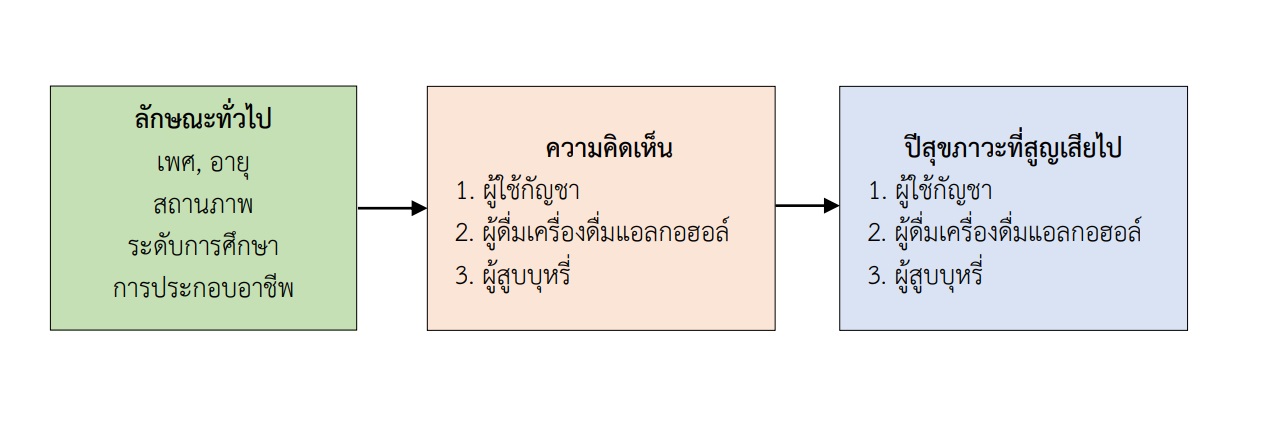Opinions of Drug Abusers towards Cannabis, Alcohol and Tobacco in Phetchabun Province
Keywords:
Cannabis, Alcohol, Cigarettes, Phetchabun ProvinceAbstract
This cross-sectional descriptive study aimed to compare the opinions toward cannabis, alcohol, and cigarette use among drug users who had received addiction treatment in Phetchabun province. The sample was 982 drug users, including 328 cannabis users, 327 alcohol drinkers, 327 cigarettes smokers. Simple random sampling was applied. The research tools were a questionnaire and a semi-structured interview questionnaire. Reliability of the questionnaires were determined using Cronbach’s alpha coefficient and obtained the values of .87 and .84, respectively. Data were analyzed using descriptive statistics and Kruskal-Wallis test.
The results showed that health impacts caused by using different substances were significantly different (p-value<0.001). In terms of disability-adjusted life years (DALYs), alcohol drinkers, cigarette smokers, and cannabis users had an average of 35.51 years, 8.70 years, and 0.5 years, respectively. The cost of marijuana had the highest economic impact (M=76,814.66 thai baht, SD=76950.31), followed by alcohol (M= 12,009.55 thai baht, SD= 13183.94) and cigarettes (M=491.33 thai baht, SD=547.17). The average social impact was the highest on cigarette smokers (M=45.95, SD=14.70), followed by alcohol drinkers (M=43.02, SD=13.93), and cannabis users (M=31.15, SD=10.09).
Per findings, cannabis use had less effects on health and social aspect than alcohol and tobacco use. However, it had more economical effects. Therefore, policy formulation, enforcement, and correction measures on substance use should be done accordingly.
References
Abuhasira, R., Shbiro, L., & Landschaft, Y. (2018). Medical use of cannabis and cannabinoids containing products – Regulations in Europe and North America. Eur J of Intern Med, 49, 2-6.
Ashton, C. H. (2001). Pharmacology and Effects of Cannabis: a Brief Review. The British Journal of Psychiatry, 178(2), 101-106.
Ashton, W. (2005). Cannabinoids in Bipolar Affective Disorder: a Review and Discussion of Their Therapeutic Potential. Journal of Psychopharmacology, 19(3), 293-300.
Brand, B. L., Classen, C. C., McNary, S. W., & Zaveri, P. (2009). A Review of Dissociative Disorders Treatment Studies. J Nerv Ment Dis, 197(9), 646-54.
Budney, A. J., Roffman, R., Stephens, R. S., & Walker, D. (2007). Marijuana Dependence and Its Treatment. Addict Sci Clin Pract, 4(1), 4-16.
Bundhamcharoen, K., Aungkulanon, S., Makka, N., & Shibuya, K. (2016). Economic Burden from Smoking-Related Diseases in Thailand. Tob Control, 25, 532–537. (in Thai)
Calabria, B., Degenhardt, L., Hall, W., & Lynskey, M. (2010). Does Cannabis Use Increase The Risk of Death? Systematic Review of Epidemiological Evidence on Adverse Effects of Cannabis Use. Drug Alcohol Rev (Review), 29(3), 318-330.
Ferguson, L., Eckard, L., Epperson, W. B., Long, L. P., Smith. D., Huston, C., et al. (2015). Influenza D virus infection in Mississippi beef cattle. Virology, 486, 28-34.
Hall, W. D., & Pacula, R. L. (2003). Cannabis Use and Dependence: Public Health and Public Policy. Cambridge: Cambridge University Press.
Joshi, L., Ponnana, M., Penmetsa, S. R., Nallari, P., Valluri, V., & Gaddam, S. (2014). Serum Vitamin D Levels and VDR Polymorphisms (BsmI and FokI) in Patients and Their Household Contacts Susceptible to Tuberculosis. Scand. J. Immunol, 79, 113-119.
Joy, J., & Mack, A. (2000). Marijuana as Medicine?: The Science Beyond the Controversy. Washington, D.C.: National Academies Press.
Kanato, M., Leyatikul, P., & Wonguppa, R. (2020). Impacts of Medical Cannabis Law in Thailand. ONCB Journal, 36(2), 27-36.
Kedsomboon, P. (2018). Cannabis and Kratom Research in Cancer Treatment. Ya-Wiphak, 36, 13-15.
Kiatying-Angsulee, N. (2018). Kratom and Cannabis are the Country's Pharmaceutical Security. Ya-Wiphak, 36, 3-8.
Le Foll, B., Forget, B., Aubin, H. J., & Goldberg, S. R. (2008). Blocking Cannabinoid CB1 Receptors for the Treatment of Nicotine Dependence: Insights from Pre-Clinical and Clinical Studies. Addict Biol, 13(2), 239-252.
Lopez, A. D., Mathers, C. D., Ezzati, M., Jamison, D. T., & Murray, C. J. L. (Eds). (2006). Global Burden of Disease and Risk Factors. Washington, D.C.: World Bank and Oxford University Press.
Maldonado, R., Valverde, O. & Berrendero, F. (2006). Involvement of the Endocannabinoid System in Drug Addiction. Trends Neurosci, 29, 225–232.
Office of the Narcotics Control Commission Ministry of Justice. (2018). Thailand Narcotics Control Annual Report 2018. Office of the Narcotics Control BoardMinistry of Justice. Retrieved May 3, 2022 from https://www.oncb.go.th/
Roche, D. J. O., Ray, L. A., Yardley, M. M., & King, A. C. (2016). Current Insights Into the Mechanisms and Development of Treatments for Heavy-Drinking Cigarette Smokers. Current addiction Reports, 3(1), 125-137.
Rujanathamrong, P. (2016). Proceedings of Management of Lrathom and Marijuana for Medicine and Health, and Social Security; 2016 Sep 27; Bangkok, Thailand. Bangkok: publisher unknown.
Sharkey, K. A., Darmani, N. A. & Parker, L. A. (2014). Regulation of Nausea and Vomiting by Cannabinoids and the Endocannabinoid System. Eur J Pharmacol, 722, 134-146.
United Nations Office on Drugs and Crime [UNODC]. (2013). World Drug Report 2013. Geneva: UNODC.
World Health statistics. (2020). Monitoring Health for the SDGs, Sustainable Development Goals. Geneva: World Health Organization.

Downloads
Published
Issue
Section
License
Copyright (c) 2022 The Southern College Network Journal of Nursing and Public Health

This work is licensed under a Creative Commons Attribution-NonCommercial-NoDerivatives 4.0 International License.
1. บทความหรือข้อคิดเห็นใด ๆ ที่ปรากฏในวารสารเครือข่าย วิทยาลัยพยาบาลและการสาธารณสุขภาคใต้ ที่เป็นวรรณกรรมของผู้เขียน บรรณาธิการหรือเครือข่ายวิทยาลัยพยาบาลและวิทยาลัยการสาธารณสุขภาคใต้ ไม่จำเป็นต้องเห็นด้วย
2. บทความที่ได้รับการตีพิมพ์ถือเป็นลิขสิทธิ์ของ วารสารเครือข่ายวิทยาลัยพยาบาลและการสาธารณสุขภาคใต้







